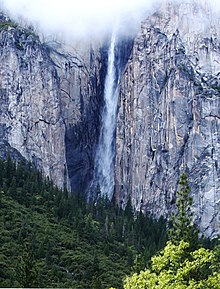Ribbon Fall,[1] located in Yosemite National Park in California, flows off a cliff on the west side of El Capitan and is the longest single-drop waterfall in North America.[2] The fall is fed by melting winter snow; while therefore dry for much of the year, the fall is a spectacular 1,612 feet (491 m) in the spring. In exceptional years, an ice cone develops at its base during the winter months similar to that which usually forms beneath Upper Yosemite Fall. This deposit can reach a depth of 200 feet, versus 322 feet for the greatest depth of the ice cone beneath the Upper Fall and Lower Fall.
| Ribbon Fall | |
|---|---|
 | |
 | |
| Location | Yosemite National Park, Mariposa County, California, United States |
| Coordinates | 37°44′09″N 119°38′54″W / 37.73583°N 119.64833°W[1] |
| Type | Plunge |
| Total height | 1,634 ft (491 m) |
| Number of drops | 1 |
| World height ranking | 99 |
Etymology
editThe Native American name for the waterfall was “Lung-yo to-co-ya,” which translates to “pigeon basket or nest,” likely referring to the band-tailed pigeons that inhabited the area. James Hutchings, however, translated the name as “long and slender” and renamed it “Ribbon Fall.” Lafayette Bunnell disagreed with Hutchings' interpretation and instead referred to it as “Pigeon Creek Fall.”[3][4]
The waterfall has also been called “Virgin’s Tears,” a name reportedly coined by a sentimental woman in the 1860s, inspired by its brief seasonal flow, which she likened to the fleeting tears of a maiden.[3]
-
The top of Ribbon Fall.
-
Ribbon Fall as seen from its base. Note the ice cone.
References
edit- ^ a b "USGS National Mapping Information: Ribbon Fall".
- ^ "World's Tallest Waterfalls: By Tallest Individual Drop". World Waterfall Database. Yosemite National Park Travel Guide. Retrieved 2020-10-09.
- ^ a b Hartesveldt, Richard J. (1955). "Yosemite Valley Place Names". Yosemite Nature Notes. Retrieved 28 December 2024.
- ^ Bunnell, Lafayette H. (1892). "Chapter XIII". Discovery of the Yosemite. p. 209. Retrieved 28 December 2024.